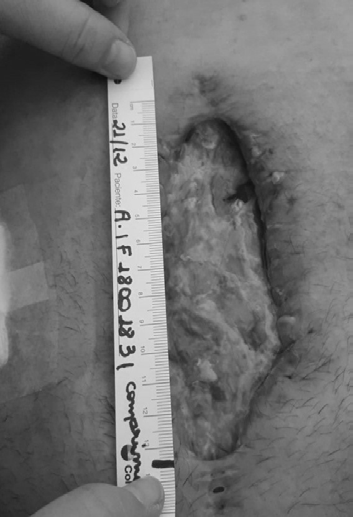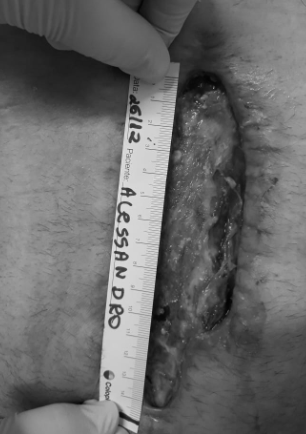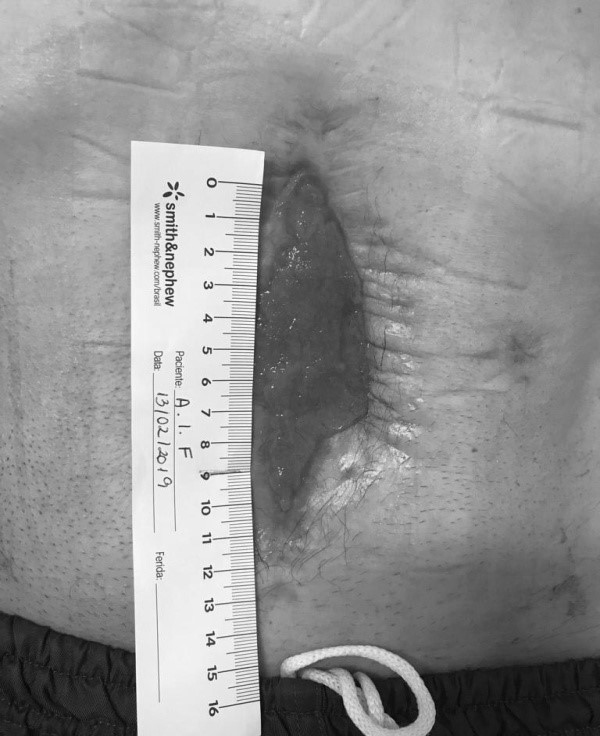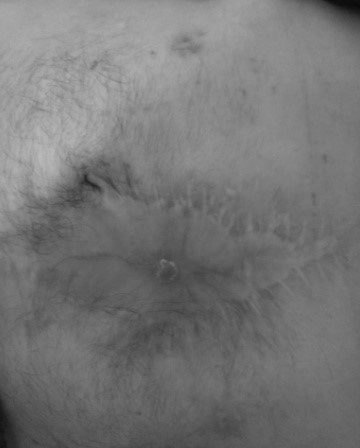Previous Issues Volume 5, Issue 1 - 2022
Use of Specific Supplementation for Healing in Surgical Wounds: Case Report
Camila Brandão Polakowski1,2, Roseli Fillus1, Maria Sofia Rosario da Luz2, Carla Simone da Silva1, Vinicius Basso Preti1, Victoria Marzagão Ribeiro3, Valéria Abrahão Rosenfeld3
1Department of Abdominal and Chest Surgery, Erasto Gaertner Hospital, Brazil
2Integrated Spiritist College of Paraná, Brazil
3Nestle Health Science
Received Date: May 03, 2022
Published Date: July 08, 2022
*Corresponding Author: Dr. Camila Brandão Polakowski 201, Jardim das Américas, Curitiba – Brazil, Zip code: 81520-060, Tel: (41) 99179-0984 E-mail: [email protected]
Citation: Polakowski CB, et al. (2022). Use of Specific Supplementation for healing in Surgical Wounds: Case Report. Mathews J Surg. 5(1):16.
Copyright: Polakowski CB, et al. © (2022).
ABSTRACT
Introduction: Nutritional deficiency can make wound healing difficult, as it weakens the immune system, decreasing the quality and synthesis of repair tissue. In this way, adequate nutritional support helps in the healing stages, as well as in the patient’s quality of life. Objective: To report a case that presented an experience of using a specific supplement for healing as part of the treatment of surgical wound healing. Method: A hyperproteic supplement was used, rich in arginine and proline, two amino acids that help in tissue recovery, in addition to containing specific vitamins and minerals, indicated for wound healing, together with a special dressing. Results: After 48 days of treatment, the patient developed granulation tissue in the bloody areas (100% granulation tissue). A reduction in depth was observed due to tissue regeneration, an increase in granulation tissue and epithelialization, in addition to a decrease in exudate. And in 82 days, complete healing of the wound. Conclusion: Specific supplementation for healing can contribute to the healing process together with an individualized, high-protein diet and with complementary care such as cleaning the wound and changing dressings, reducing the depth, dimension and visual appearance of the surgical wound.
Keywords: Surgical wound; Healing; Oral Nutritional Supplement; Proline.
INTRODUCTION
Surgical wounds are considered acute, planned, and performed with juxtaposition of edges, heal by first intention and tend to spontaneously regress, completing an expected period. When there is no approximation of edges or there is suture dehiscence, the healing of these surgical wounds occurs by second intention, requiring longer time to heal, as there is space between the edges, requiring the formation of granulation tissue to fill it until they occur epithelialization and contraction [1].
Several factors can lead to poor wound healing. Some factors are local, such as oxygenation and infection, other factors are systemic and are related to the general condition of the individual, such as age, severe trauma, radiotherapy, anticancer drugs, corticosteroids, diabetes, obesity and nutrition. However, these factors are interconnected as systemic factors change local factors and influence wound healing ability [2].
Nutritional deficiency can make healing difficult, as it weakens the immune system, decreasing the quality and synthesis of repair tissue [1]. Nutrition is essential for tissue repair and that different nutritional states can negatively influence recovery, also emphasizing that obesity, protein-calorie malnutrition, deficiencies in specific nutrients or specific adverse circumstances (dehydration, infection, or hyperglycemia) complicate the normal healing process [3]. The delay in the wound healing process leads to a decrease in the patient’s quality of life, increasing morbidity and mortality, in addition to causing an economic burden on the health system [4]. In addition, they cause considerable impact on the patient, as they determine pain, immobility, disability, social changes resulting from hospitalizations and withdrawal from social life [5].
A high-protein diet, vitamins A, C, E and minerals such as copper, zinc and iron, as well as amino acids such as arginine and proline, are essential to help prevent and improve wound healing, thus reducing the suffering of patients, reducing hospital stay and costs of maintaining this patient in the hospital [6].
Proline is a signaling molecule, a sensor of cellular energy status, and a source of pyrroline-5-carboxylate (P5C) and the superoxide anion, participating in redox reactions in humans and animals. Proline and its metabolite (hydroxyproline) constitute about one-third of collagen-forming amino acids. Collagen comprises approximately 30% of the body’s proteins and is the main extracellular component of connective tissues (for example, skin, tendon, and cartilage [11].
The nutritional supplement has two important components in its formula: hydroxylysine and hydroxyproline, precursors of lysine and proline, amino acids present in collagen, which act by stimulating the production of hyaluronic acid, which in turn increase the production of skin fibroblasts [7]. Indicated for patients with healing problems such as surgical wounds, pressure injuries, chronic injuries and care where dressings and wound cleaning are included as part of the treatment [7].
In this context, the objective of this case report is to present an experience of using a specific supplement for healing as part of the treatment of surgical wound healing.
METHOD
CASE REPORT OF A PATIENT TREATED AT THE THORAX SERVICE OF HOSPITAL ERASTO GAERTNER FROM 12/21/2018 TO 03/13/2019.
Case report approved by the Hospital Ethics Committee; CAE: 44779221.6.0000.0098.
To release the pictures of the surgical wound images, the patient signed the image use rights term, signed during the intervention period. In addition to recording the images, information was collected from the patient’s medical record.
This is a 41-year-old white male patient diagnosed with Squamous Cell Carcinoma (SCC) of the middle esophagus, pathological staging (pTNM): pT3 pN1. Patient underwent Ivor-Lewis esophagectomy and jejunostomy with gastric tube reconstruction. Four days after the procedure, she developed a fistula from the intrathoracic esophagogastric anastomosis, progressing to mediastinitis. Surgical treatment was chosen. Due to mediastinitis and hemodynamic instability, it was decided not to perform a new anastomosis. The patient underwent cervical terminal esophagostomy, resection of the entire gastric tube with closure of the first duodenal portion and exclusive feeding via jejunostomy. Four months after the procedure, a new esophagocoloplasty surgery was performed to reconstruct the upper intestinal tract so that the patient could return with oral feeding.
An anthropometric evaluation was carried out, where observed severe weight loss (18%), and on the day of surgery weight was 60.4 kg. In the biochemical tests, the only change was in the albumin level (albumin at 2.9g/dL).
Offer a polymeric, hypercaloric and hyperproteic diet via jejunostomy, with a caloric intake of 1,980Kcal/day, 99g of protein, associated with a protein module (26g), totaling 125g of protein per day, in addition to an oral diet according to acceptance with total caloric intake in 250Kcal.
On the 22nd postoperative day, the patient evolved with total dehiscence of the laparotomy scar. Nutritional counseling was carried out and nutritional intervention was carried out with specific supplementation for healing. Novasource Proline® is indicated for patients with wound healing problems, burns and chronic wounds, in addition to complementary care in which dressings are included as part of the treatment.
Clinical assessment and nutritional status were performed through an anamnesis covering past and current pathological history, laboratory tests and eating habits. For anthropometry, body weight and height were measured. To classify the nutritional status, the Body Mass Index (BMI) was used, calculated through the coefficient Body Weight (kg) / Height (m)², according to the cut-off points recommended by the WHO, 1995 [8]. The percentage of loss was calculated weight (%PP). With the result, the percentage of weight loss and the time of this loss were classified, based on the proposed: significant weight loss of 1-2% in 1 week, 5% in 1 month, 7.5% in 3 months and 10% in 6 months. To calculate caloric, protein and water needs, the recommendation of nutritional therapy in cancer patients for cancer patients was used, which recommends 30 to 35 kcal/kg/day, 1.2 to 2 g of protein, in addition to vitamins and minerals according to the recommended daily intake (RDI) [9].
RESULTS
The calculated caloric goal was 2,115Kcal/day (35Kcal/Kg/day), 120g/day of protein (1.5 to 2g/Kg/day) and 1,810ml/day of water (30ml/Kg/day).
On the 22nd postoperative day, total dehiscence of the laparotomy sutra was observed, with a large amount of exudate, in addition to 100% of the lesion with the presence of devitalized tissue. The lesion measured approximately 14 cm in length, 7 cm in width and 3 cm in depth (Figure 1). The patient was discharged from the hospital with individualized nutritional intervention, continued with oral and enteral diets.
Figure 1: Operative wound at the beginning of treatment.
The intervention began with specific supplementation for healing, in addition to reformulating the enteral diet. Patient instructed to administer 1,520Kcal, 60g of protein from a complete diet, in addition to a protein module with 20g of protein, associated with specific supplementation for healing with an additional caloric intake of 550Kcal, plus 40g of protein. Totaling 2,070Kcal/day (35Kg/Kg/day) and a total protein supply of 120g (2g/Kg/day), in addition to hydration.
Every five to seven days after hospital discharge, the patient returned to the clinic with the medical team, nutritionist and nurse for clinical reassessment, nutritional status and surgical wound. To monitor the evolution of the lesion, records were made through photographs, obtained by the specialist nurse, from the beginning to the end of the treatment. Also, measurements were taken with a ruler to check the size of the lesion before and after the intervention.
Five days after the intervention, an improvement and decrease in devitalized tissue, increased granulation and medium amount of exudate were observed (Figure 2).
Figure 2: Aspect of the lesion after 7 days of intervention.
In addition to the diet described above, dressings were changed, and the wound was cleaned.
After 48 days of treatment, the patient developed granulation tissue in the bloody areas (100% granulation tissue). There was a reduction in depth due to tissue regeneration, an increase in granulation tissue and epithelialization, in addition to a decrease in exudate (Figure 3).
Figure 3: Aspect of the lesion 48 days after the intervention
After 82 days, there was significant healing of the surgical wound (Figure 4), and specific supplementation for healing was suspended, maintaining a standard diet with a total caloric intake of 2070Kcal (35Kg/Kg/day) and a total protein supply of 119g (2g/Kg/day). He kept a consultation with the medical team and the nutritionist every 3 months. In July 2019, the patient had tumor recurrence with tracheal compression, progressing to death in August 2019.
Figure 4: Image of the lesion after 82 days of nutritional intervention.
DISCUSSION
Individuals at nutritional risk or malnourished demand that nutritional therapy be individualized to guarantee the healing process. Two conditionally essential amino acids, such as arginine and proline, play an important role in wound healing, as they are precursors of fundamental substrates, such as nitric oxide and collagen [10]. Protein deficiency can impair capillary formation, fibroblast proliferation, proteoglycan synthesis, collagen synthesis, and wound remodeling. Protein deficiency also affects the immune system, with increased susceptibility to infection [2].
In the case report, a reduction in depth due to tissue regeneration, an increase in granulation tissue and epithelialization, in addition to a decrease in exudate, was observed in 48 days. The use of specific supplementation for healing during the four-week period showed an average weekly wound edge growth of 1.85 mm in patients with diabetes and 3.0 mm per week in those without diabetes, being 2.9 and 4.6 times higher than expected according to the literature [11].
Collagen is the main protein component of connective tissue and is mainly composed of glycine, proline and hydroxyproline. Collagen synthesis requires hydroxylation of lysine and proline and co-factors such as ferrous iron and vitamin C, and a deficiency in either of these co-factors leads to altered healing [1].
Arginine is a necessary amino acid during periods of peak growth, stress and injury. They have several effects on the body, including modulation of immune function, wound healing, hormone secretion, vascular tone, and endothelial function. It is also a precursor of proline and as such a certain level of arginine is required for collagen deposition, angiogenesis, and wound contraction. Arginine improves immune function and stimulates wound healing in healthy and sick individuals. In situations of psychological stress, there is an increase in the metabolic requirement of arginine and its supplementation has been shown to be an effective adjuvant therapy in wound healing [1-2].
Tissue repair generates an increase in caloric and protein demand, as well as a greater need for some micronutrients, amino acids acquired at the expense of muscle catabolism, therefore, greater consumption of energy and nutrients are necessary during tissue repair [12-13].
Proline is critical for collagen synthesis during the healing process. Proline levels increase at the wound site, reinforcing its active participation in tissue recovery [11]. Strategies that increase proline bioavailability can optimize collagen biosynthesis and consequently improve the healing process [11].
In the case report, it was observed that after 5 days of the intervention there was a decrease in the devitalized tissue and after 48 days there was a reduction in the depth of the wound. A study that evaluated the effects of a specialized oral nutritional supplement containing arginine and proline, vitamins A, C and E, zinc and selenium, on the repair of difficult-to-heal wounds, observed a significant reduction in wound surface area [11-13].
A high-protein diet, vitamins A, C, E and minerals such as copper, zinc and iron, in addition to amino acids such as arginine, are essential to help prevent and improve wound healing, reducing hospital stay and maintenance costs patient in hospital [6].
CONCLUSION
Specific supplementation for healing can contribute to the healing process, together with an individualized, high-protein diet and with complementary care such as cleaning the wound and changing dressings.
DECLARATION OF INTEREST
We participants in the case report research entitled “Use of specific supplementation for wound healing” declare that we have no conflict of interest, in addition to not having funding for the research.
VMR: Pis a member of medical and scientific affairs at Nestlé Health Science, Brazil, patent holder of the product Novasource Proline (200ml).
CONTRIBUTION OF EACH AUTHOR
CBP: case follow-up, data collection, article writing RF: case follow-up, data collection, article review MSRL: review of the article CSS: case follow-up, article review VBP: case follow-up, article review VMR: article review
REFERENCES
- Campos A. (2007). Borges-branco Alessandra,Groth. WoundHealing. ABCD, ArqBrasCirDig, São Paulo, 20(1):51-58. Available in: https://www.scielo.br/j/abcd/a/wzTtGHxMQ7qvkBbqDLkTF9P/?format=pdf&lang=pt. Acesso 28 de dezembro de 2021.
- Leal E, Carvalho E. (2014). Wound healing: the physiological and the pathological. Portuguese Journal of Diabetes. 9(3):133-143. Available in: http://www.revportdiabetes.com/wp-content/uploads/2017/10/RPD-Vol-9-n%C2%BA-3-Setembro-2014-Artigo-de-Revis%C3%A3o-p%C3%A1gs-133-143.pdf
- Campos, ACL. (2013). Treatise on nutrition and metabolism in surgery. Rio de Janeiro: Editora LtdaRubio. 33.
- Montenegro S. (2012). Proteinsandwoundhealing. Nutricias Magazine. APN. 14: 27-30. Available in: https://periodicos.ufjf.br/index.php/hurevista/article/download/27129/20169/116782.
- Oliveira F, Oliveira B, Santana R, Silva B, and Carvalho Candido J. (2016). Classifications of nursing interventions and outcomes in patients with wounds: cross-mapping. Rev GaúchaEnferm. jun;37(2):e55033. Available in: http://dx.doi.org/10.1590/1983- 1447.2016.02.55033.
- Teixeira E, Araujo C, LOPES P, Baptista D, and J.D. Pinto. (1995). Assessment of nutritional status and food consumption of amputees and pressure ulcer patients treated at a Hospital Rehabilitation Center. World health. 35(4):448-453. Available in: <https://bvsms.saude.gov.br/bvs/artigos/avaliacao_estado_nutricional_consumo_alimentar_pacientes_amputados.pdf
- Castro F, Duarte R, Silveira T. (2020). Use of novasourceproline as an adjunct in the treatment of pressure injuries. e-Scientia, Belo Horizonte. 13:11-20. Available in: https://unibh.emnuvens.com.br/dcbas/article/download/2842/pdf
- World health organization (WHO). (2005). BMI classification. WHO,.Available in: http://www.who.int/bmi/index. jsp? introPage = intro_3.html.
- Horie L, Barrére A, Castro M, Liviera A. (2019). BRASPEN guideline for nutritional therapy in the cancer patient. BRASPEN J. 34:2-32.
- Cereda E, Klersy C, Serioli M, Crespi A, D'Andrea F, et al. (2015). OligoElement Sore TrialStudyGroup. A nutritional formula enriched with arginine, zinc, and antioxidants for the healing of pressure ulcers: a randomized trial. Ann Intern Med. 162(3):167-74. Available in: https://pubmed.ncbi.nlm.nih.gov/25643304/
- Mehl A, Damião A, Viana S, Andretta CP. (2021). Hard-to-heal wounds: a randomised trial of an oral proline-containing supplement to aid repair. J Wound Care. 30(1):26-31. Available in: https://pubmed.ncbi.nlm.nih.gov/33439085/
- Sampaio L, Costa J, Reis S. (2018). Impact of protein malnutrition on skin wound healing in rats. Rev. Nutr. 31(5):433-442. Available in: http://ref.scielo.org/tknx8t.
- Matos LBN, Piovacari SMF, Juliana FR, Alves TM, et al. (2020). Campanha Diga Não à Lesão por Pressão. BRASPEN J. 35(Suppl 1):2-32.



